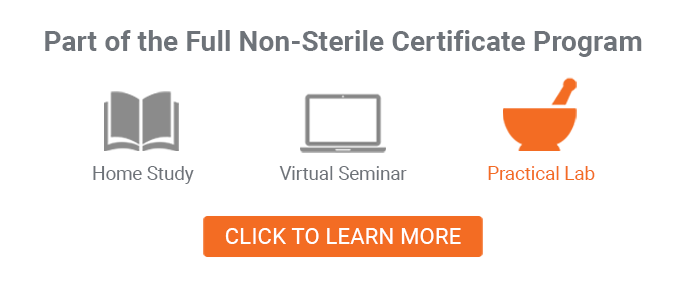Course description
Elements of a unique process experienced in the Virtual Seminar can now be realized in this Practical Lab, which serves as the basis for the development, and subsequent preparation of any non-sterile dosage form containing any appropriate active pharmaceutical ingredient. The unique elements include:
- Compounding by composition (i.e., powder blends, and powder-in-liquid mixtures in the form of solutions or dispersions)
- Preparatory states-of-matter and final dosage form states-of-matter (i.e., solids, semisolids and liquids)
- Routes of delivery and delivery systems
- Sites of administration and target sites of action
Featured Activities:
- Skills Development
- Weighing powders
- Measuring liquids
- Geometric Addition
- Clean transfers of semisolids
- Weight variance testing
- Organoleptic assessments
- Beyond-Use-Dating assignments
Featured Dosage Forms:
- Cellulose-based hydro-alcoholic gel in an actuated dispenser
- Oral transmucosal films using syringe-to-syringe mixing technique
- Capsules using 100-count capsule machine including aliquot calculation
- PEG-based troches including mold fill calculation
- Rapid dissolve tablets
- Oral suspension including pH step
- Suppositories using a 12-count flexible mold
- Topical cream emulsion, using an electronic blade mixer, mill and planetary motion mixer (no blades)
Instructional design
The Practical Lab is a hands-on application-based compounding skills development session followed by the preparation of eight (8) dosage forms each with a unique chemical composition, routes of delivery and delivery system. The eight prepared compounded medications undergo a qualitative and quantitative assessment. The Practical Lab program learning assessment consists of an assessment of learned preparatory techniques, which includes those highlighted during the skills development session complemented by scores allocated to the qualitative and quantitative assessment results.
Course format
2-day live practical lab (12 hours) where you will receive hands-on experience developing non-sterile compounding skills, and preparing eight (8) dosage forms. Each compounded dosage form concludes with a quantitative and qualitative assessment. Participants complete a self-directed learning assessment co-signed by the program facilitator.
Combine this program with Non-Sterile Compounding: Live Virtual Seminar, where you will learn about non-hazardous and hazardous drug compounding, divided into four subsections: Business Basics, Creating a Culture of Quality, Compounding Calculations, and Scientific Principles to complete the Full Certificate Program.*
Intended audience
- Pharmacists, Pharmacy Technicians, Pharmacy Managers, Designated persons in positions of responsibility, and Quality Assurance & Quality Control officers looking to advance their practical non-sterile compounding skills related to any professional setting.
- Auditors / Inspectors looking to hone their assessment skills in concert with the standards described and detailed in this Activity.
Learning objectives
Pharmacists
- Demonstrate proper donning and doffing of personal protective equipment; non-hazardous and hazardous
- Demonstrate how to manage a workstation, its equipment and chemical inventory
- Demonstrate how to properly sanitize a workstation in a non-hazardous and hazardous drug environment
- Demonstrate how to properly manage and dispose of waste; non-hazardous and hazardous
- Demonstrate how to clean and disinfect an analytical balance
- Demonstrate how to verify the internal calibration of an analytical balance
- Record data in standard operating procedure logs
- Demonstrate the use of electromechanical equipment, and reusable and disposable devices
- Perform a broad range of non-sterile compounding techniques
- Prepare a number of non-sterile compounded medications
- Determine the beyond-use date for non-sterile compounded medications
- Select appropriate dispensing containers for finished non-sterile dosage forms
- Complete formulation records for finished non-sterile dosage forms
- Analyze finished dosage forms by assessing organoleptic properties and performing weight variance testing
Pharmacy technicians
- Demonstrate proper donning and doffing of personal protective equipment; non-hazardous and hazardous
- Demonstrate how to manage a workstation, its equipment and chemical inventory
- Demonstrate how to properly sanitize a workstation in a non-hazardous and hazardous drug environment
- Demonstrate how to properly manage and dispose of waste; non-hazardous and hazardous
- Demonstrate how to clean and disinfect an analytical balance
- Demonstrate how to verify the internal calibration of an analytical balance
- Record data in standard operating procedure logs
- Demonstrate the use of electromechanical equipment, and reusable and disposable devices
- Perform a broad range of non-sterile compounding techniques
- Prepare a number of non-sterile compounded medications
- Determine the beyond-use date for non-sterile compounded medications
- Select appropriate dispensing containers for finished non-sterile dosage forms
- Complete formulation records for finished non-sterile dosage forms
- Analyze finished dosage forms by assessing organoleptic properties and performing weight variance testing
Testimonials
“A true hands-on experience with experts that teach the secrets of successful compounding. I learned a lot regarding compounding techniques, quality control, packaging, and the availability of compounding tools and aids. This training will help my day-to-day practice!”
Parvaneh Moussavian | Pharmacist
Financial support
This learning activity has received financial support from MEDISCA Inc. in the form of an educational grant.
Copyright
This CE Activity is Copyright © 2002-2024 LP3 Network.
*Composed of two components – The Non-Sterile Training: Home Study & Seminar and The Non-Sterile Training: Practical Lab – The Certificate Program provides Pharmacists and Pharmacy Technicians with a well-rounded, comprehensive, practical, and applicable understanding of non-sterile compounding – everything from foundations in pharmaceutical compounding, to regulations and standards of practice, to business and marketing, to quality control, to the hands-on preparation of non-sterile dosage forms, and much more. Each program has an associated learning assessment that must be successfully completed to fulfill the requirements of the Full Certificate Program. The Live Virtual Seminar and Live Lab Training must be taken within 6 months of each other. Upon successful completion of the Full Certificate Program, participants will receive a Certificate of Completion acknowledging their achievement that can proudly be displayed in their compounding pharmacy.

